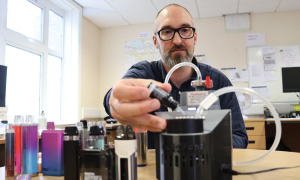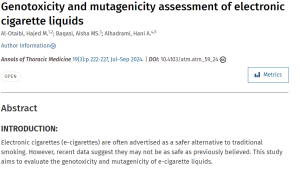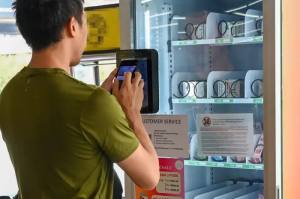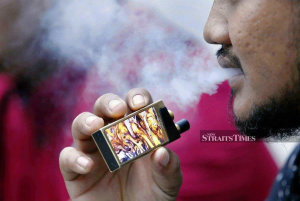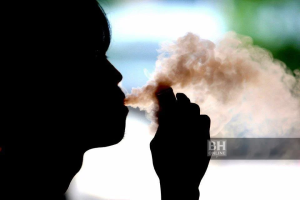“Rise of disposable e-cigarettes has focused regulators around the world on what they fear is an explosion of vaping among young people”

The vaping industry turns 20 this year, but Ira Simeonidis fears the golden age of e-cigarettes is already wafting away. “It’s a bit destroyed,” says the organizer of Hall of Vapes, Europe’s largest vaping trade fair, held in Stuttgart this month.
His festival once drew more than 20,000 visitors, who attended talks, partied with DJs, and browsed rows of exhibits by renowned designers showing off their latest “mods”, elaborately crafted devices for inhaling nicotine – and other substances of choice.
“It was for professional and passionate vapers,” Simeonidis says. “A community thing, to get together, drink beer, vape and see each other once a year.”
But no more. While the festival was suspended for two years during the Covid-19 pandemic, the vaping world transformed. Markets around the world have been flooded with mass-produced disposable vapes, and a product that was once the province of speciality stores now fills the racks of corner shops, mobile-phone accessory stands and booths hawking tourist tat.
The number of designers exhibiting at his fair more than halved this year, Simeonidis says. There were no concerts, and many of his stalls were taken up by companies selling disposable technology. “They’re cheaper and it’s catastrophic for the environment with their lithium batteries,” he laments. “Also, there are the kids.”
‘A game of whack-a-mole’
The rise of disposables has not only upset vaping purists. It is has intensified the focus of regulators around the world on what they fear is an explosion of vaping among young people, including school-age children, enticed by dark marketing of the products by social media influencers and kid-friendly flavours like crème brûlée, sour sherbet and Swedish fish.
Data on the surge is still emerging, but a survey of British children found the proportion who vape more than doubled in the year to 2022, while the use of disposables soared by 600%. Both those trends were largely among children who were already smokers, though studies from Australia, New Zealand and the US suggest more significant numbers of teenagers who vape in those countries might have never touched traditional cigarettes.
Vaping regulations around the world
Another way to measure the explosive growth of disposables is the flood of candy-coloured cartridges that now scatter the surroundings of many universities and schools. “A guy who picks up litter told me he thought they were highlighters – and students were getting very studious in the parks,” says Freddie Dawson, a Dublin-based editor at Tamarind Intelligence, a firm that tracks the industry.
“You just need to walk down the street and see what [vapes] young people are using – it’s always, always going to be disposables.”
Even as debate continues over whether vapes are a life-saving tool to wean smokers off cigarettes, or an avenue for the nicotine industry to hook a new generation of addicts – and they may be both – concern over teenage use and the environmental toll of the devices is driving a new wave of regulation around the world.
Australia has announced that it will impose the strongest restrictions of any developed market, completely banning recreational vaping while limiting the sale of the devices to pharmacies – and only with a doctor’s prescription.
Other countries are unlikely to go that far, Dawson says, but many are tightening their own regimes, inching closer to treating vapes the way they do cigarettes. The Netherlands banned flavoured vapes this year, while France says it could prohibit disposable vapes by the end of 2023. In Ireland, children under 18 can legally buy vapes from any store – a loophole the Irish parliament is moving to close.

New Zealand has implemented a world-first generational smoking ban, preventing anyone currently aged 14 and under from legally buying cigarettes for the rest of their lives. More Kiwi adults vape (8.3%) than smoke (8%) according to the latest data, but as elsewhere, that growth is particularly strong among young people. Vaping rates among 14- to 15-year-olds have tripled, and legislators are spooked.
As some doctors and health groups call for a tougher stance, New Zealand’s government is re-examining its regulations. Associate health minister Ayesha Verrall, who has fronted many of the smoking changes, admitted in January that “youth vaping rates are too high” and the government “need[s] to strike a better balance”.
The UK is holding an awkward pose, trying to curb what one expert has claimed is an “epidemic” of use by children, while at the same time offering vape starter kits to English smokers – in recognition that its own commissioned research says vaping is not danger-free, but “poses a small fraction of the risks of smoking” in the short and medium term.
Estimates of the number of people who vape around the world vary wildly, from 40m to more than twice that many, with the majority thought to be in rich or upper-middle income countries where, even with the imposition of new duties, vaping is still cheaper than smoking heavily taxed cigarettes.
But as the price of vapes has fallen, the devices have proliferated in less wealthy countries such as South Africa, Malaysia and dozens of others where regulations are nascent, and lawmakers are starting to voice similar worries over their use by adolescents.
In China, where most of the world’s vapes are manufactured, flavours other than tobacco were banned in 2022, in recognition of their apparent danger to children – though exporting those same flavoured products to the rest of the world is still permitted, and booming.
India was four years ahead of Australia in banning vapes outright, but its experience raises another question for lawmakers: how effectively can vapes be regulated? A survey published this year of young Indians found more than one in five had vaped at least once, despite the ban, with another fifth intending to try it in the next year.
“The sale of e-cigarettes is rampant, and its sale by home deliveries and through the internet is extensive,” says Monika Arora, a vice-president of the Public Health Foundation of India. “Our work with school students is showing they’re experimenting from a very young age, class 8 [age 13-14] onwards.”
Governments are likely to confront similar challenges as they seek to claw vapes back from the hands of young people. Ban specific flavours, for example, and manufacturers may tweak their recipes slightly to circumvent the rules. Prohibit vapes completely, and the black market is likely to live on – as it does for any drug. “It’s a game of whack-a-mole,” says Dawson.
Enthusiasts may believe the golden age of e-cigarettes is over. But the vaping era, with all the fraught questions it coughs up, is only beginning.
This article was amended on 17 May 2023 to clarify that Australia’s tough measures against recreational vaping have been announced but are not yet law. Also, the embedded world map has been updated to reflect recent legislation banning public vaping in Taiwan.
Source: The Guardian

